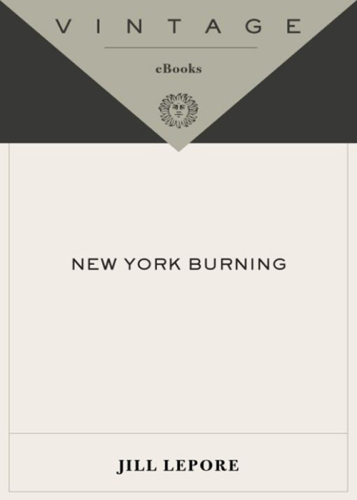
New York Burning
Liberty, Slavery, and Conspiracy in Eighteenth-Century Manhattan
کتاب های مرتبط
- اطلاعات
- نقد و بررسی
- دیدگاه کاربران
نقد و بررسی

August 1, 2005
Juilliard graduate and Broadway actress McDonald offers a wry and meaty interpretation of Lepore's intense social history of the Manhattan slave uprising of 1741. That winter, black and Spanish slaves allegedly set 10 fires around the city, resulting in widespread panic and a draconian roundup of any slave who was rumored to be even tangentially involved in the conspiracy. McDonald does a fine job with the text, which is heavy on trial transcripts and newspaper reportage. Her voice and Lepore's descriptions create an almost visceral portrait of the events, including-note to the faint of heart-some shocking, CSI-worthy descriptions of the ensuing executions, which included burning at the stake. McDonald sometimes butchers the pronunciation of the Spanish names mentioned in the proceedings, but in general her rendering is spot-on, and her voice is by turns animated, disapproving or conspiratorial. The first two hours can be a bit abrupt and confusing, as this abridgment has omitted much of the background information that helped print readers make sense of the large cast of characters. However, this condensation makes for an exciting recital, and by the second half, listeners will be on the edge of their seats.

Starred review from May 2, 2005
With riveting prose and a richly imagined re-creation of a horrible but little-studied event, Bancroft Prize–winning historian Lepore (The Name of War: King Philip's
War and the Origins of American Identity
) deftly recounts the circumstances surrounding a conspiracy in pre-Revolutionary Manhattan. In 1741, its teeming streets erupted into fire in at least 10 locations. At first, rival political parties blamed each other for the conflagrations, but they joined forces against black slaves when a young white woman named Mary Burton testified that she had witnessed several slaves conspiring to kill whites and gain their liberty. The colony's leaders arrested and tried at least 100 black men and women. Eventually, the colonial Supreme Court sentenced 30 men to death; 17 were hanged (along with the four supposed white ringleaders) and 13 burned at the stake, based solely on Burton's testimony. Out of fear, several slaves testified against others, and the bulk were sent into brutal slavery in the Caribbean. Drawing primarily on New York Supreme Court justice Daniel Horsmanden's Journal of the Proceedings in The Detection of the Conspiracy formed by Some White People, in Conjunction with Negro and Other Slaves,
Lepore demonstrates that whites' fear of black rebellion led them to blame any threat to the colony on the activity of slaves. In this first-rate social history, Lepore not only adroitly examines the case's travesty, questioning whether such a conspiracy ever existed, but also draws a splendid portrait of the struggles, prejudices and triumphs of a very young New York City in which fully "one in five inhabitants was enslaved." 17 illus., 1 map.

August 15, 2005
Prize-winning author Lepore (history, Harvard Univ.; "The Name of War: King Philip's War and the Origins of American Identity") offers new analysis of an episode in Colonial New York that revealed the city's racism, the so-called New York Conspiracy, or Negro Plot, of 1741. At the time, New York's pluralistic white community depended upon slaves, who constituted 20 percent of the population. When ten suspicious fires broke out, one white accuser claimed that they were set by black slaves, and the populace panicked at the perceived uprising. The trials resulted in 26 blacks and four whites being hanged or burned at the stake, with numerous other blacks punished with deportation. Lepore cites Thomas J. Davis's "A Rumor of Revolt" and Peter Hoffer's "The Great New York Conspiracy of 1741" but aims for something different. She seeks to distinguish between the kind of liberty achieved by literate whites (e.g., freedom of the press) and the kinds of liberty that proved elusive for blacks. She also argues that the New York Conspiracy may in fact have been imagined by a white populace all too aware of its oppression of blacks and conversant with its own factional politics. Recommended for university history students and specialists, although it will also benefit the informed lay reader. [See Prepub Alert, " LJ "4/1/05.] -Frederick J. Augustyn Jr., Library of Congress
Copyright 2005 Library Journal, LLC Used with permission.

Starred review from June 1, 2005
Fear of a slave revolt convulsed New York City in 1741, and Lepore analyzes the course of events in this meticulous but accessible work of historical scholarship. Beginning with the proceedings of trials and executions compiled by the episode's chief inquisitor, Lepore then branches into contextual aspects of colonial America. She combines the cultural pattern of the slave system, political factionalism stemming from the famous John Peter Zenger libel trial of 1735, and the prevalent mindset that as far as enslaved black people (who constituted one-fifth of the city's population) were concerned, there were no coincidences, only conspiracies. Magistrate Daniel Horsmanden virtually personified this background; he mobilized to smoke out an insurrectionary intrigue after a spate of fires consumed several wealthy owners' buildings. Lepore's ensuing narrative of Horsmanden's industriousness is a stellar performance, explaining legal intricacies as it vivifies the anxiety rippling across the city as one confession instigated another and eventually conflated, in Horsmanden's apologia, into an all-purpose papist plot. Previously a recipient of the Bancroft Prize (for " The Name of War," 1998), Lepore may once again win that prestigious honor in American history for this searing work.(Reprinted with permission of Booklist, copyright 2005, American Library Association.)

























دیدگاه کاربران